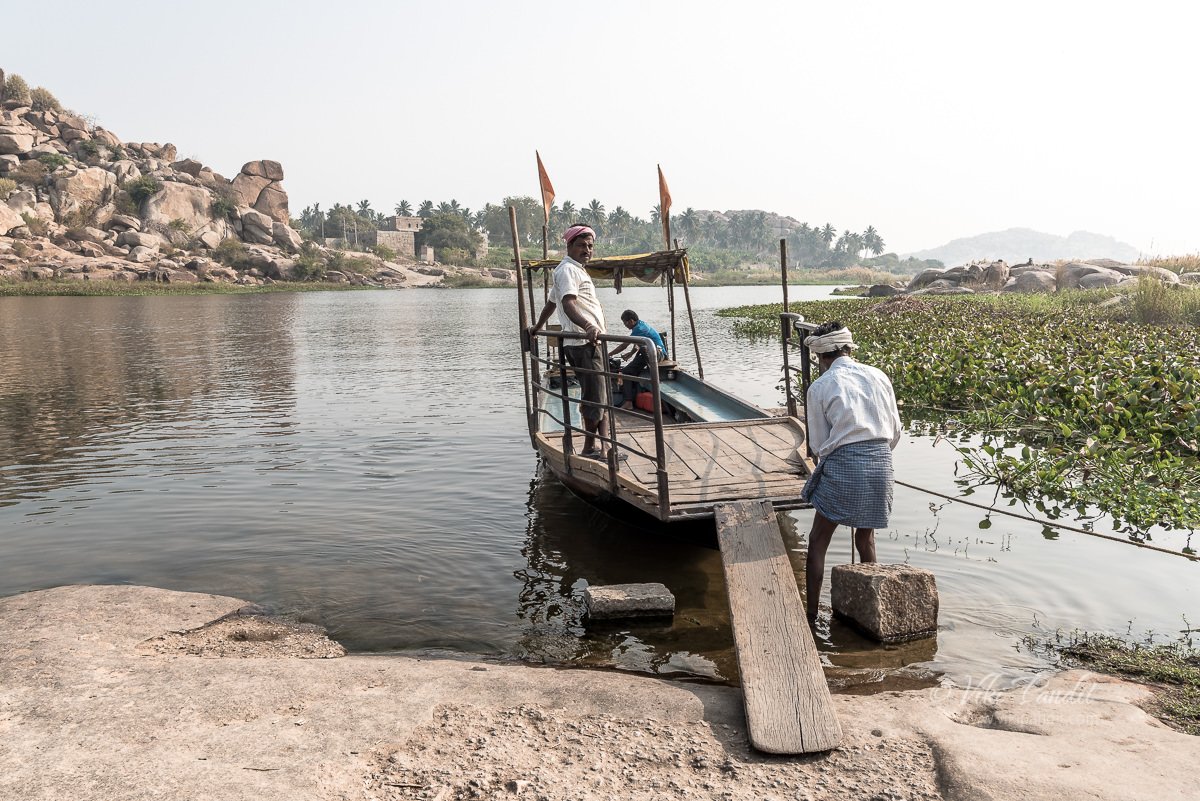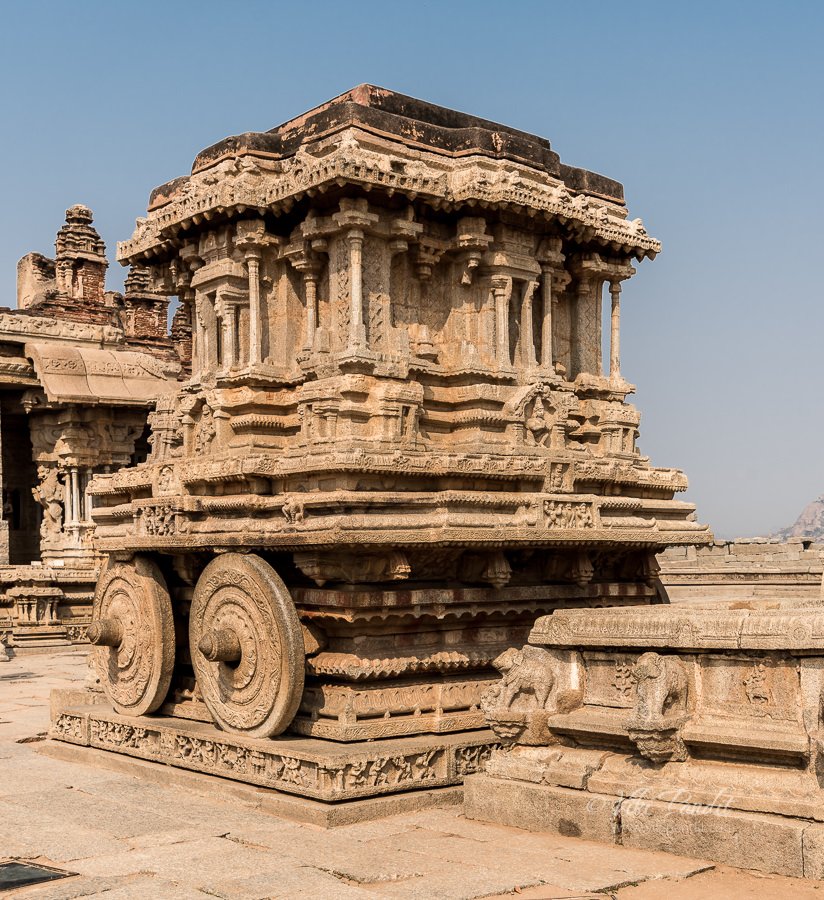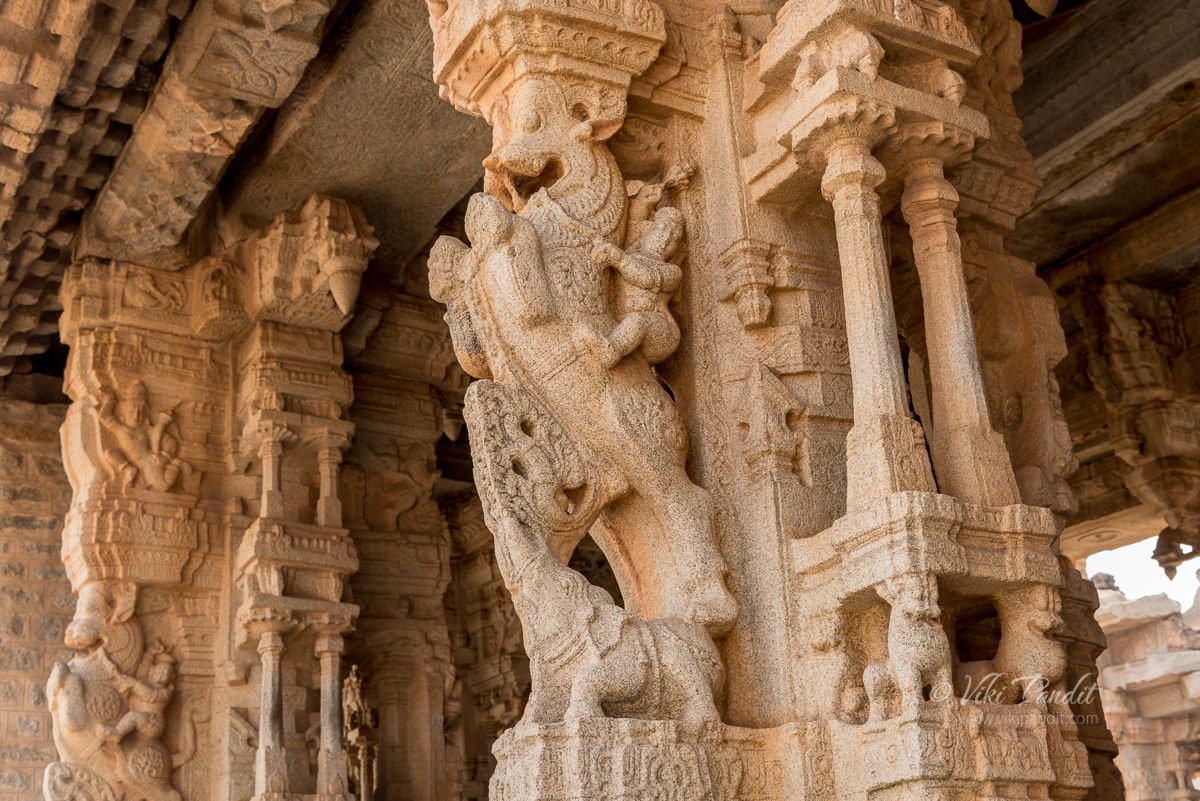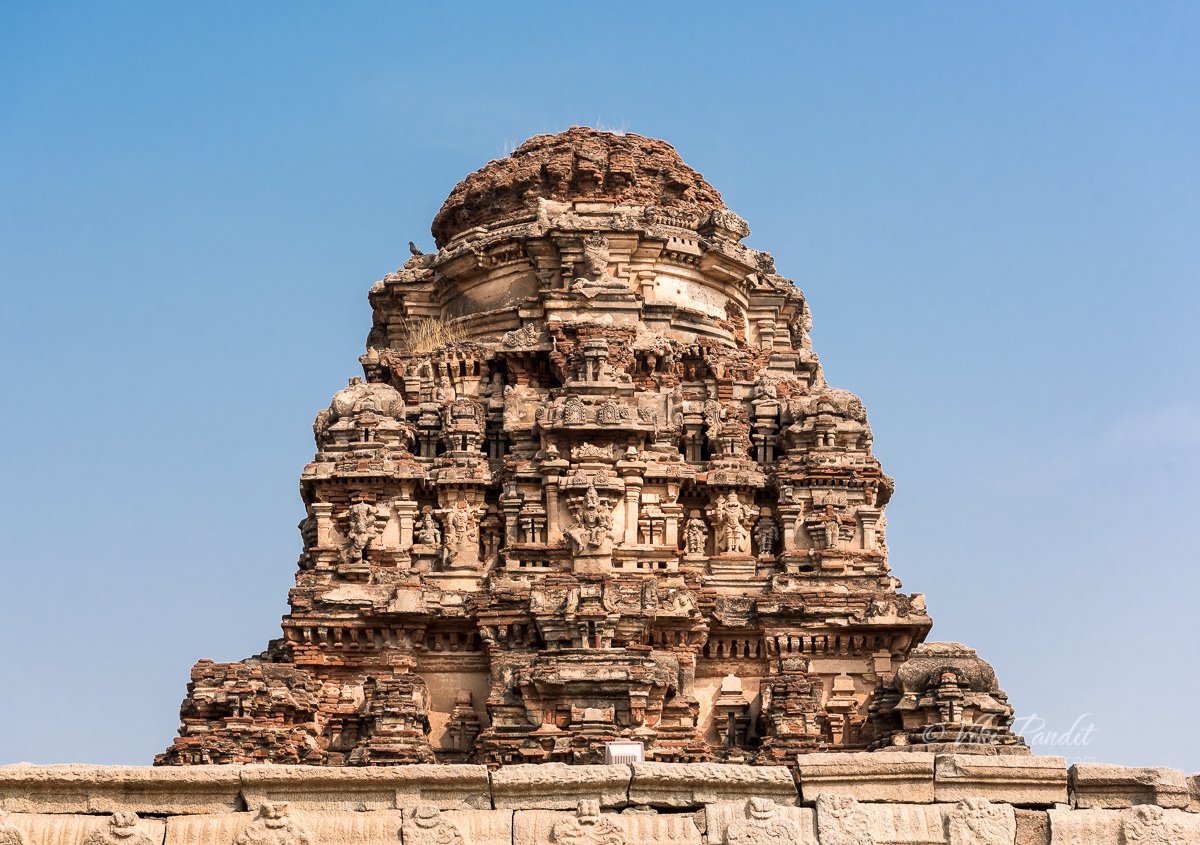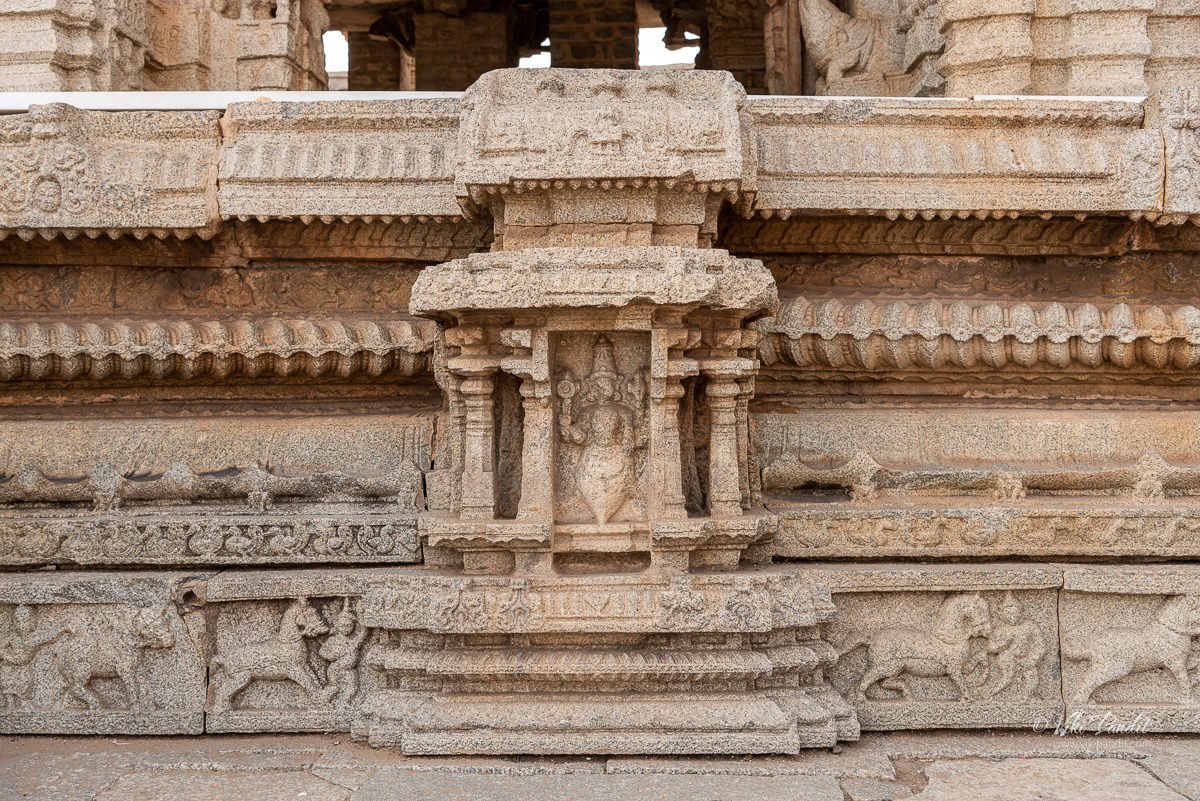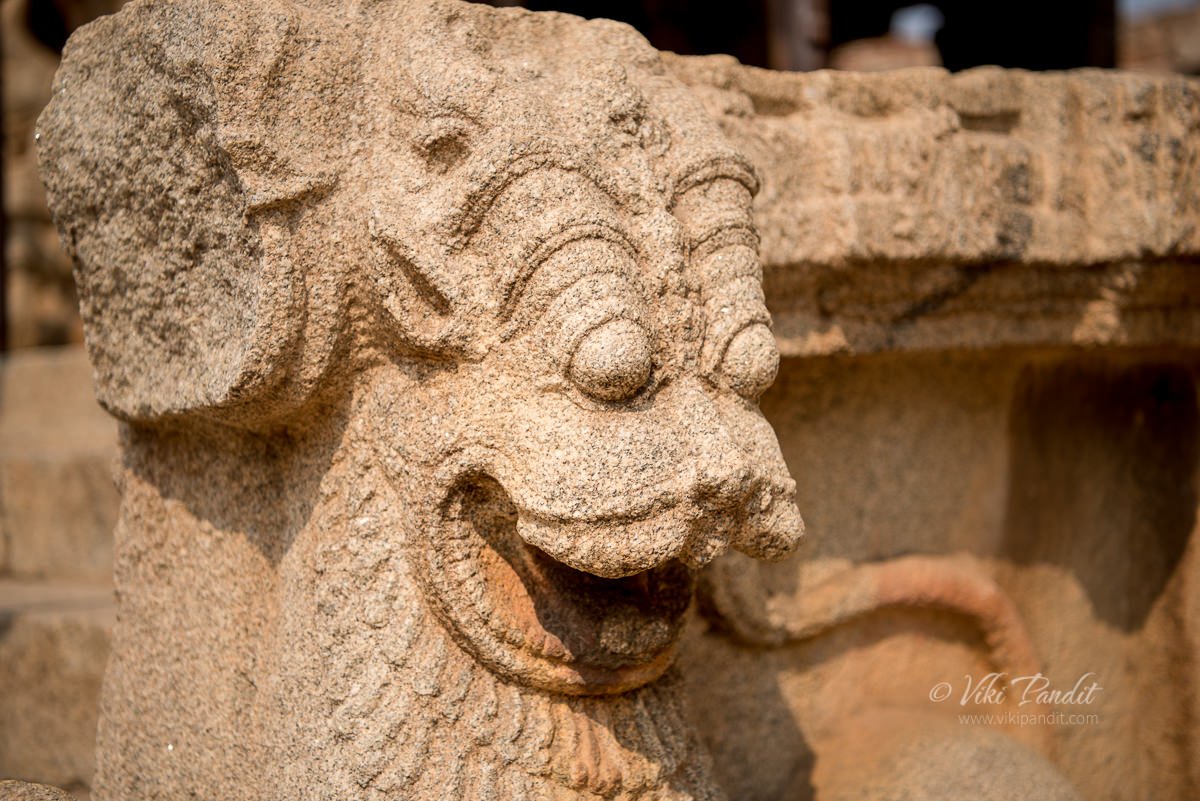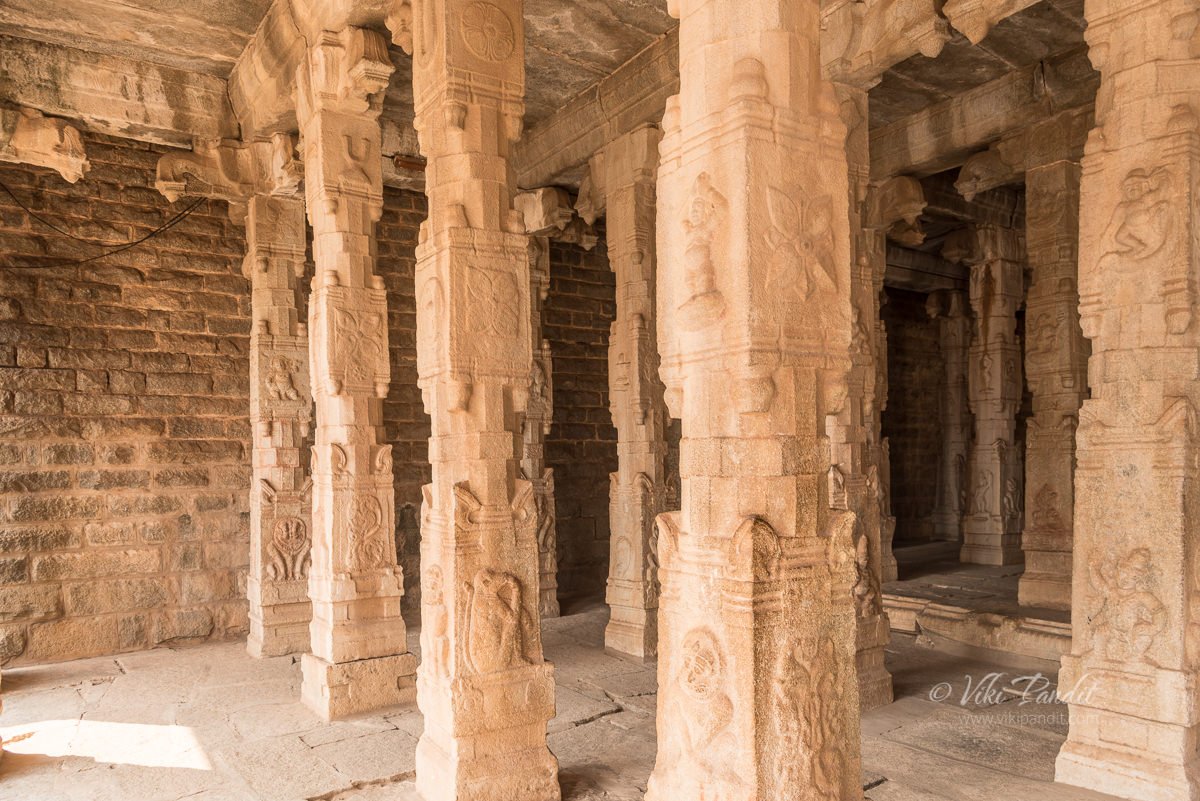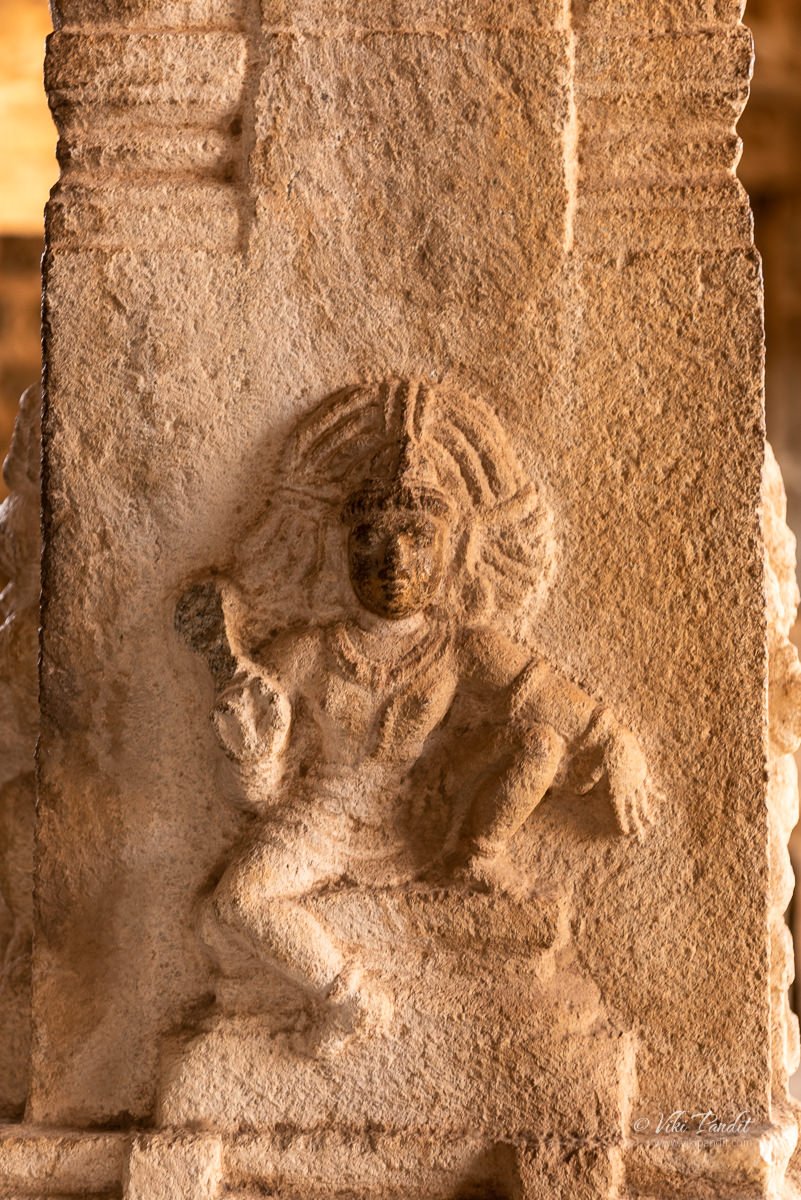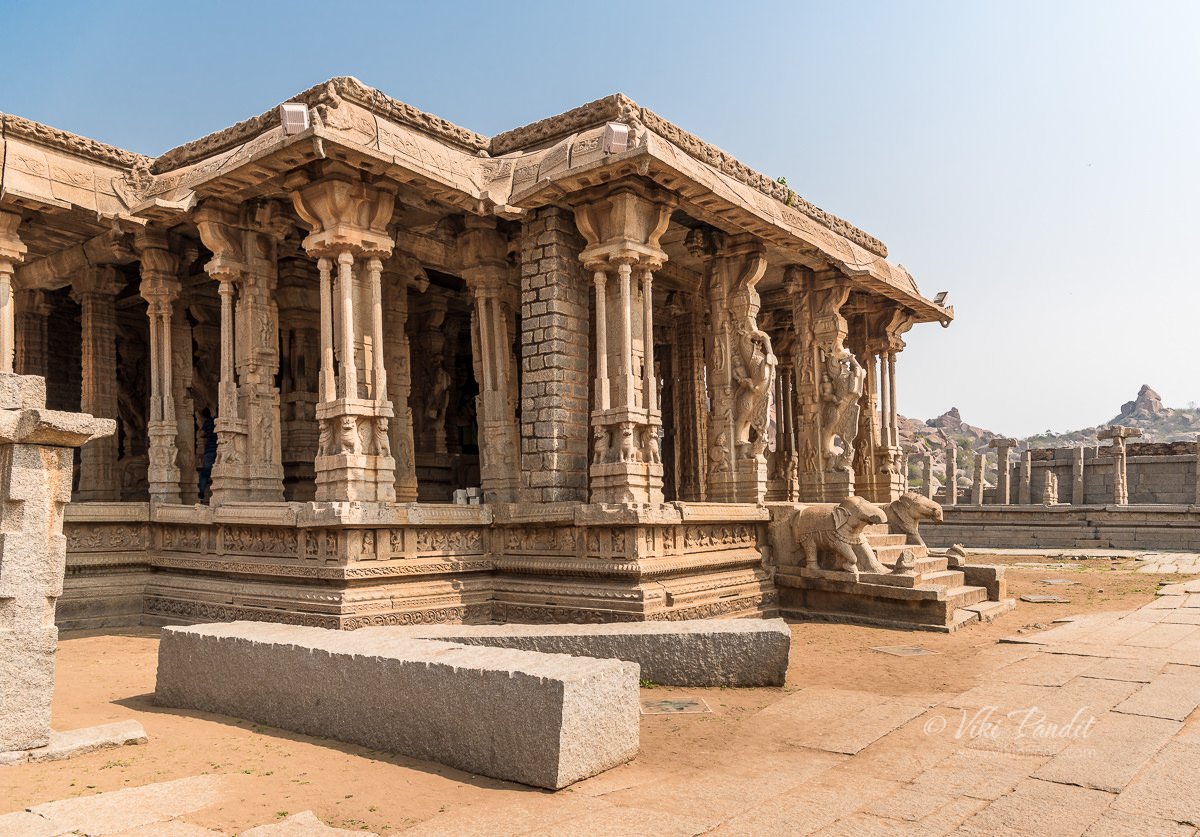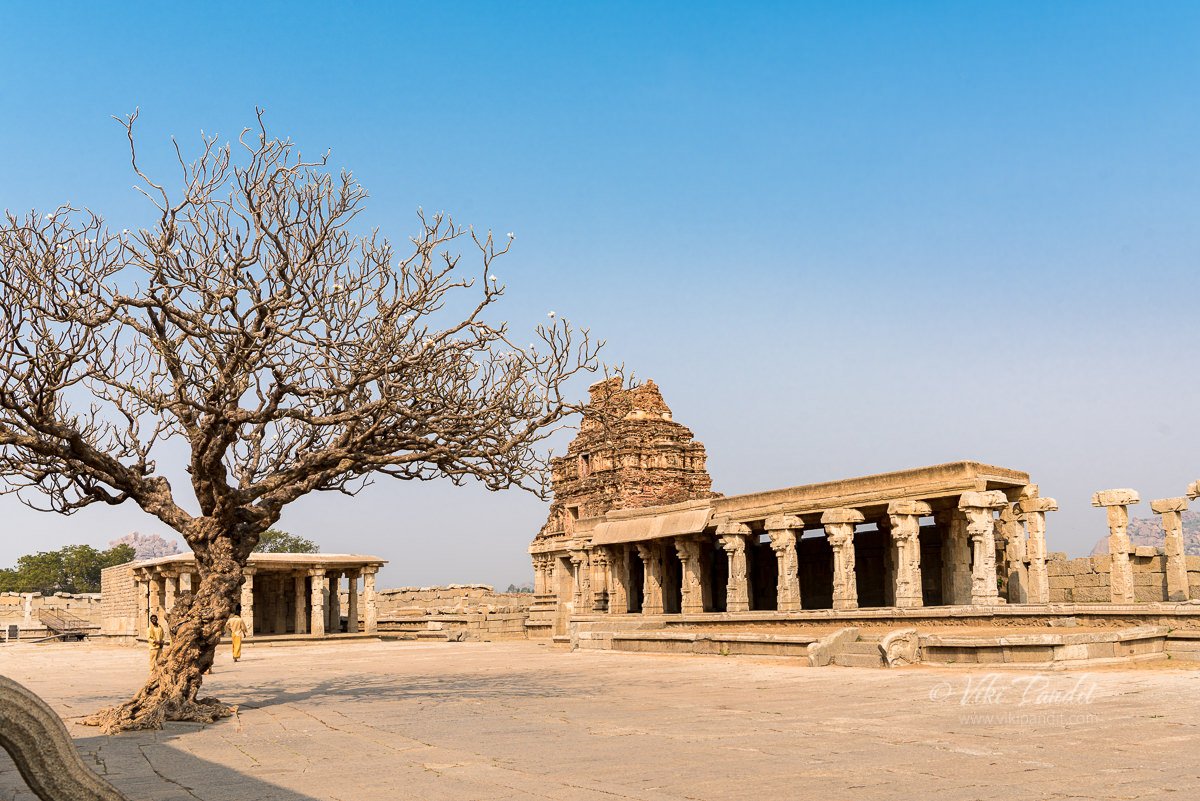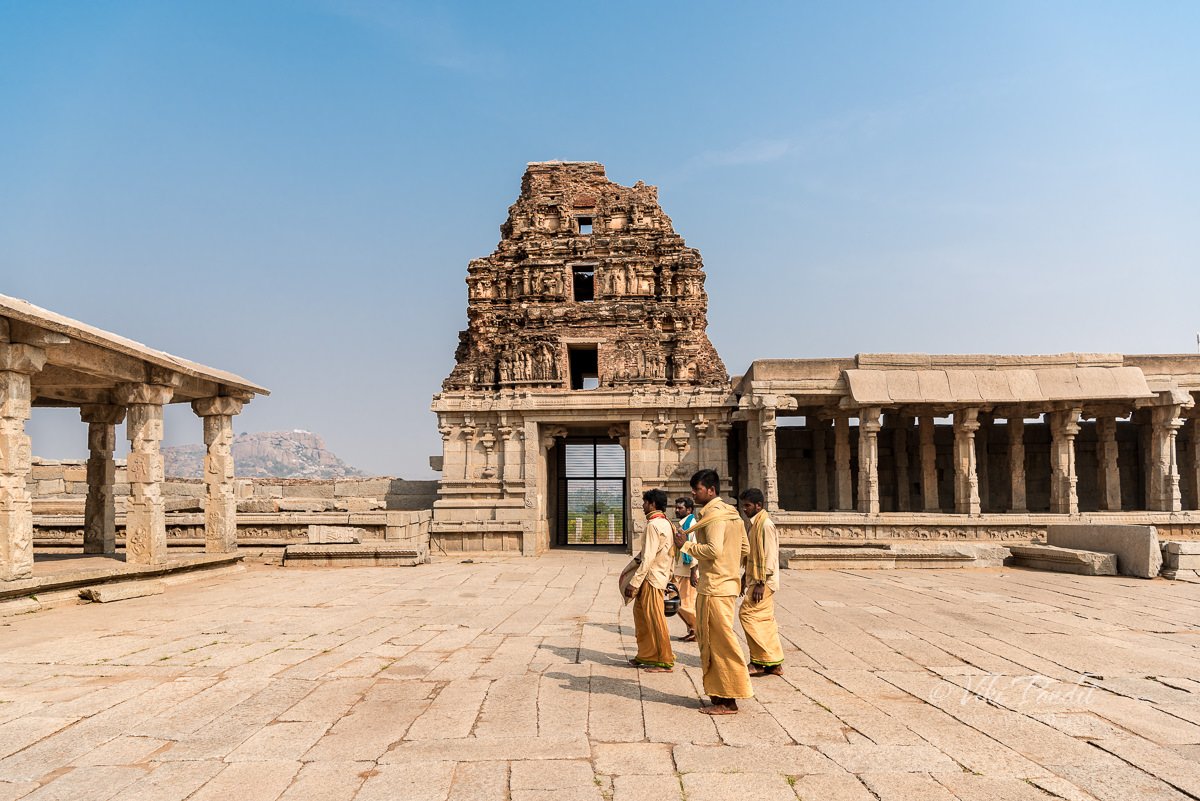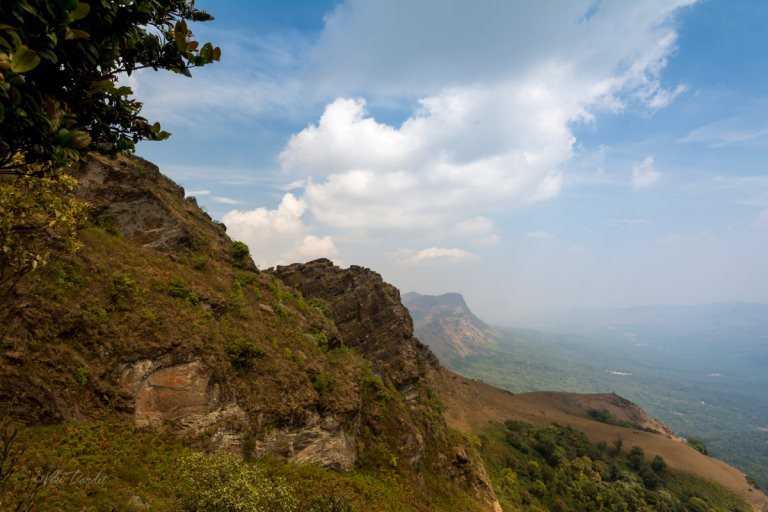Today I went on a heritage walk to the majestic Vittala Temple. Built around the 15th century CE, and expanded several times by succeeding kings of the Vijayanagar empire, it is the epicenter of Hampi’s attractions. This time, I was in Hampi along with a trekking group from Bangalore.
It was another day of missed opportunities. I was awake at 5 am, ready for new experiences in Hampi. We were supposed to observe the sunrise from Anjaneya hill as per schedule but our trek leader himself got up at 6 am and by that time hiking up Anjaneya hill was a lost cause.
I wandered around the open spaces near our lodging. it was pleasant with no vehicular pollution or noises in the serene surroundings.
By the time everyone was ready, it was already 9 am. We drove down to Anegundi, the nearest town where we took our breakfast in one of the local dhabas. The idlis, served by a lovely lady were delicious. Just across the street, a wooden Rath was stationed. These chariot like structures are used during the rath festival in these parts.
From there the bus dropped us off near Talwar Gatta, where a ferry helped us across to the other side. Honestly, I was a bit scared, since they didn’t have any life jackets and one is always hearing about ferries toppling over in India.
History of Hampi
Hampi, believe it or not, the whole town is a UNESCO World Heritage Site. It was traditionally known by many names, the prominent ones being Pampapura or Pampakshetra. These names were derived from Pampa which was the name of the river Tungabhadra in those ancient times.
The recorded history of Hampi goes back a long way. Archaeologists have discovered rock edicts from the time of Emperor Asoka in Bellary, not very far from here, dating 269-232 BCE, suggesting this region could have been a part of the Maurya Empire way back in the 3rd century BCE.
Along-with the prosperity of the Vijaynagar empire, Hampi became a centre of religious and educational activities. But I would be biased to other dynasties if I only sing praises of the Vijaynagara kings. Hampi had already gained quite popularity by the 10th century. Inscriptions at Virupaksha temple, a kilometer along the Tungabhadra, are evidence to Chalukya kings making land grants to the temple.
Later between the 12th and 14th centuries CE, kings of the Hoysala Empire also built temples dedicated to the goddess Durga and lord Shiva. During this time, Hampi had almost become a secondary home of the Hoysala kings.
With time, it went on to become the epicenter of the Vijayanagar Empire in the 14th century. Chronicles left by Persian and European travelers, particularly the Portuguese, state Hampi was a prosperous, wealthy and grand city near the Tungabhadra River, with numerous temples, farms and trading markets.
By 1500 CE, Hampi was considered the world’s second-largest medieval-era city attracting traders from Persia and Portugal. Unfortunately, nothing lasts forever and the splendor of Hampi attracted many invaders. In 1565, the Vijayanagar Empire was attacked and defeated by a coalition of Muslim sultanates. Its capital was conquered, pillaged and destroyed by sultanate armies leaving the heritage city in ruins. It is said these invaders looted the city over a period of six months, snatching the valuables and burning all that remained to the ground.
History of Vittala Temple, Hampi
After a short walk from the river, I found myself at the parking area for Vittala Temple. From here visitors can either wait for a buggy or simply walk to the temple, which is a bit of a distance away. A queue had already built up, so if you desire a peaceful experience please come early. While others in my trek group waited for the guide, I made my way to the temple.
The Vittala temple was originally built in the 15th century AD, during the reign of King Devaraya II (1422 – 1446 A.D.), one of the rulers of the Vijayanagara Empire. Many successive kings have expanded and enhanced the temple campus during their regimes to the present form.
Records from the 16th centure redfer to this complex as “Vitthala.” The temmple complex extends over a distance of about a kilometer. The temple was called the Vijaya Vittala predominantly. In one of the records, it is also mentioned as Kanada Vitthala. It is assumed that the “Vijaya” in the name Vijaya Vitthala indicates a celebration victory.
The road leading to the temple is in a completely ruined state. This road was once the location of a thriving market place. The market was known as the Vittala Bazaar and was famous for horse trading. The ruins of the market can be seen on both sides of the road.
The buggy dropped me off near the entrance tower. One typically accesses the campus through the eastern gate, next to which the ticket counter is located. Behind the ticket counter lies the remains of a township called Vittalapura that existed around this temple complex. The first foundations of the temple were laid around 1505 CE. The eastern gate or gopuram was constructed between the years 1513 to 1516.
The Vittala temple complex
The temple is built in the form of a sprawling campus with compound wall and gateway towers. There are many halls, pavilions and temples located inside this campus. The iconic temple has amazing stone structures such as the incomparable stone chariot and the fascinating musical pillars.
The Vittala Temple is also known as Shri Vijaya Vitthala Temple. It is dedicated to Lord Vitthala, an incarnation of Lord Vishnu. An idol of Vitthala-Vishnu was enshrined in the temple.
Notable among the structures are the shrine of the Goddess (Devi shrine), Maha Mantapa or main hall (Sabha Mantapa or congregation hall), Ranga Mantapa, Kalyana Mantapa (marriage hall), Utsava Mantapa (festival hall), and the famous Stone Chariot.
The Vijaya Vitthala temple is a stupendous creation of the Vijayanagar artists with few paralells in the architectural history of medieval India. The main attractions of the Vittala Temple are listed below:
Stone Chariot of Vittala Temple
The first structure I noticed was the sculpted Stone Chariot, which is considered to be the most stunning architecture of the Vijayanagara kingdom. Designed in the shape of an ornamental chariot with the idol of Garuda, it is an iconic landmark of Hampi. The structure is classified as a Karakkoil, a temple fashioned after temple chariots which are taken in procession around the temple during festivals.
The Stone Chariot or Ratha stands in the courtyard of complex and welcomes the visitors as they enter the temple grounds. Even though it appears to be one, the Stone Chariot is not a monolithic structure. As per Hindu mythology, Garuda is the carrier of Lord Vishnu and its image is enshrined into the sanctum. The popularity if this iconic sculpture has led to it being part of the Indian currency in the denomination of Rupees fifty.
The stone chariot may be the first structure see as you enter the Vittala complex, but it is also the most recent.
Just like the Shore temple of Mahabalipuram, this shrine was also built with blocks of granite. The joints are cleverly hidden in the carvings and other decorative features that adorn the stone chariot. The chariot was built on a rectangular platform. The base platform is adorned with mythical battle scenes chiseled into the granite on all sides.
The chariot is adorned with a set of four finely sculptured granite wheels. Though the chariot is not resting on it, the four giant wheels are extremely well detailed and good enough to compete with real life ones. A series of concentric floral motifs decorate the sides of the wheels. The platform, where the wheels rest, shows clamps were later added to fix it from moving around the axis. Some older pictures of the stone chariot show it with a shikhara and the kalasha which have now eroded away. The wheels of the stone chariot are said to be once functional and could be rotated by the people. But some years ago the ASI cemented the wheels in order to avoid causing damage to them.
In front of the chariot two elephants are positioned as if they are pulling the chariot. However if you look carefully, you can see the difference in the style of sculpting. These elephants were supposedly added at a later stage after the chariot was completed. Originally two horses were carved in that position. The rear legs of the horses can be still seen just behind these elephant sculptures.
Maha Mandap of Vittala Temple
On leaving the Stone Chariot, I walked down to the main hall in front of the Vittala temple. Unfortunately the entrance to the Maha Mandap was blocked for maintenance. The first time I was here a couple of years back, people used to be allowed inside the main hall.
The Maha Mandapa or main hall of the Vittala Temple is situated in the inner courtyard, bang in the center of the temple complex just behind the Stone Chariot. It is a structure of immense beauty, sitting on a highly ornate base carved with a series of floral motifs. Maha mandap along the axis of the main temple has a pillared hall with three entrances. A series of steps flanked by elephant balustrades gives access to this elevated open hall called the Maha mandap.
The balustrades on the east and west porch of this hall is more dramatic with giant lion Yalis fighting the relatively dwarf elephants.
There are forty pillars lining the facade of the temple. The central part of the Maha Mandap has sixteen intricately decorated pillars having beautiful sculptures of Narasimha and Yali.
These richly carved giant monolithic pillars set of sixteen pillars forms a rectangular court. The sikhara of the Maha Mandap is very much in ruins, more so because it was created out of mud bricks.
The Musical Pillars of the Maha Mantapa:
The Dolotsava Mandap is other main attraction of the Vittala Temple. The most outstanding components of the Vijay Vitthala Temple is the eastern pavilion of the Maha Mandap.It was originally called Dolotsava Mandap or “Hall of Musical Pillars” This large mandap is renowned for its 56 musical pillars carved out of huge single pieces of resonant stone. This cluster of musical pillars are also known as SAREGAMA pillars, named after the notes of the classic Indian music – Sa, Re, Ga, Ma, etc. It is said musical notes are emanated when the pillars are tapped gently.
The original foundations of the Dolotsava Mandap were laid sometime during the reign of two Devarayas (1406 – 1446 CE ) of the Snagama Dynasty. It experienced further expansion during the time of Tuluva Krishnadevaraya (1503 -1528 AD) It was further expanded upon during the reigns of Achyutdevaraya( 1529 – 1546 AD) and Sadasivaraya (1542-1565 AD)
The analysis of these pillars has revealed that the rocks are resonant because of the presence of metallic ore and large amounts of silica.
The base is decorated with carvings of warriors, horses, swans and several other ornamental designs. The lowermost of it is a chain of horses, its trainers and the traders.
Every main pillar is surrounded by 7 minor pillars. These 7 pillars emit 7 different musical notes from the representative musical instruments. The notes emanating from these pillars vary in sound quality depending on whether the instrument is a percussion, string or wind instrument. When one of the columns is struck, the reverberation moves though the other nearby columns. However, if you find yourself at this site on a Sunday afternoon, forget about being able to hear any music over the ‘hum’ of the large crowds that throng this temple.
The emission of musical notes from stone pillars was a mystery that fascinated many people down the centuries. After conquering the region, the Mughals tried to burn down the temple but it turned out futile since the temples were carved out of granite.
After the Mughals, the country fell prey to the British. They too tried to damage the temple every way they could, pillaging away any artifact that could be carried away to their country. Two of these pillars were cut off by the British, who were surprised by the musical notes of the pillars and wanted to examine them in more detail. However, they found out that the pillars had nothing inside them.
I believe that tapping the musical pillars to emit musical notes is now prohibited, as tapping over the years have caused some damage to the musical pillars of the Maha Mandap. But the local guides fake it on the pillars of the other mandaps to please the tourists.
Most of the granite and sandstone towards the base have survived. The influence of Srivaishnava sect is seen at this temple complex which is revealed by observing minor shrines to the south, west and north. Around this main mandapa are four smaller halls: (clockwise from east)
- Kalyan mandap
- 100-columned mandap
- Amman shrine and
- Bhoga mandap
After capturing the exteriors of the Maha Mandapa, I moved towards the Kalyan mandapa on the left.
Kalyan Mandap
You can find more pictures of the Kalyan Mandap here.
100 Pillar Mandap
The “Hundred Pillared Hall” has altogether 108 pillars in all. It is said to be commissioned in 1554 AD. Below are close-up shots of some of the pillars.
Amman shrine
From the 100 column mandap, I made my way towards the back of the Maha Mandap where a small temple lies un-bothered and unattended by tourists.
Bhoga Mandap
For some reason they built a second marriage hall in the temple grounds. Generally all the temples I have visited only have one Kalyan Mandap. It might well have been for some other reason, the facts of which have been lost to time.
Some other interesting structures around the temple complex
While walking around the complex, I found this lone tree on the grounds. Beside the tree, along the enclosing walls lies a small structure. It is not very decorated and I am not sure about its functionality either, but it looks beautiful. I recall this from the first time I visited Hampi in 2014.
A few steps ahead lies the northern gate. Like the other structures, the base is very much as it was centuries back, but the top parts created using mud are in ruins.
Ruins of Vittala Temple in Hampi
The Vittala Temple is in a partially ruined state. The sanctum of the temple once contained an idol of Lord Vittala. However, now the sanctum is devoid of any idol. The region around the Vittala temple was called Vitthalapura. It hosted a Vaishnava matha (monastery), designed as a pilgrimage centred around the Alvar tradition.
According to historical memoirs left by Portuguese and Persian traders, the city of Hampi was of metropolitan proportions and the Vitthala temple the crown jewel of the kingdom. I have written another article on the still standing ruins of Hampi if you would want to read about the humble beginnings of the forgotten city.
In 1565, at the Battle of Talikota, a coalition of Muslim sultanates entered into a war with the Vijayanagara Empire. They captured and beheaded the king, followed by a massive destruction of the infrastructure of Hampi. The city was pillaged, looted and burnt for six months after the war, then abandoned as ruins. The central western hall of the temple was ruined during the attack of the Delhi Sultanate that eventually led to the downfall of the Vijayanagara Empire in 1565 CE and the end of Hampi.
I have been to Hampi twice and yet it feels like I have to come back many a more times to truly capture its essence in full. I was prepared to stay another day, but the living conditions of our lodgings forced me to catch the bus and head back to Bangalore.
Thanks for reading. Please leave me a comment if you liked the post or follow my story as I visit the mythical birthplace of luv & kush from the epic tale of Ramayana .
Festivals at Vittala Temple in Hampi
The temple has floodlights installed inside the temple complex. The lights illuminate the Vittala Temple Complex at night and offer a majestic view of the beautiful structure against the dark night sky. But if you want to see it, you should come in winter when the days are small. In summers the place closes up well before sunset.
Hampi Festival (November)
This is the largest festival at Hampi. Generally they are scheduled for 3 days during the first week of November. The celebrations typically packed with shows of music, dance puppet shows fireworks and a pomp procession as the grand finale showcasing the cultural richness of the place.
Purandaradasa Aradhana (January/February)
The annual Purandaradasa festival is held at the temple complex. The festival is held every year to commemorate the birthday of the ancient poet Purandaradasa who lived in Hampi. The 2-3 days long program is scheduled during the months of January or February.
Use of tripods is not permitted inside the temple campus.
The monument opens from 8.30 am in the morning to 5.30 pm in the evening. However, try to visit this place soon it opens in the morning. That is the only time you can explore peacefully before the crowd builds up.
Admission fee is Rs 30 for Indian citizens and Rs. 500 for foreign nationals. Preserve this ticket. If you are in Hampi for the whole day, you can use the ticket on the same day to also enter the Zenana Enclosure area.
Early-to-mid-16th century
King Devaraya II
₹30 for Indian citizens / ₹500 for foreign nationals
8:30 – 17.30 hrs
Disclaimer: The information presented in this article is based on the time I visited the premises. Note that there might be changes in the prices of merchandise and admission fees that might have occurred after this article was published. At times the facility might also be closed for repairs or for variety of other reasons. Kindly contact the facility or facilities mentioned in this article directly before visiting.
Usage of this site indicates acceptance of my Terms and Conditions.
Credits: The historical information presented herein is gathered mostly from local guides that were re-inforced via historical writings.


